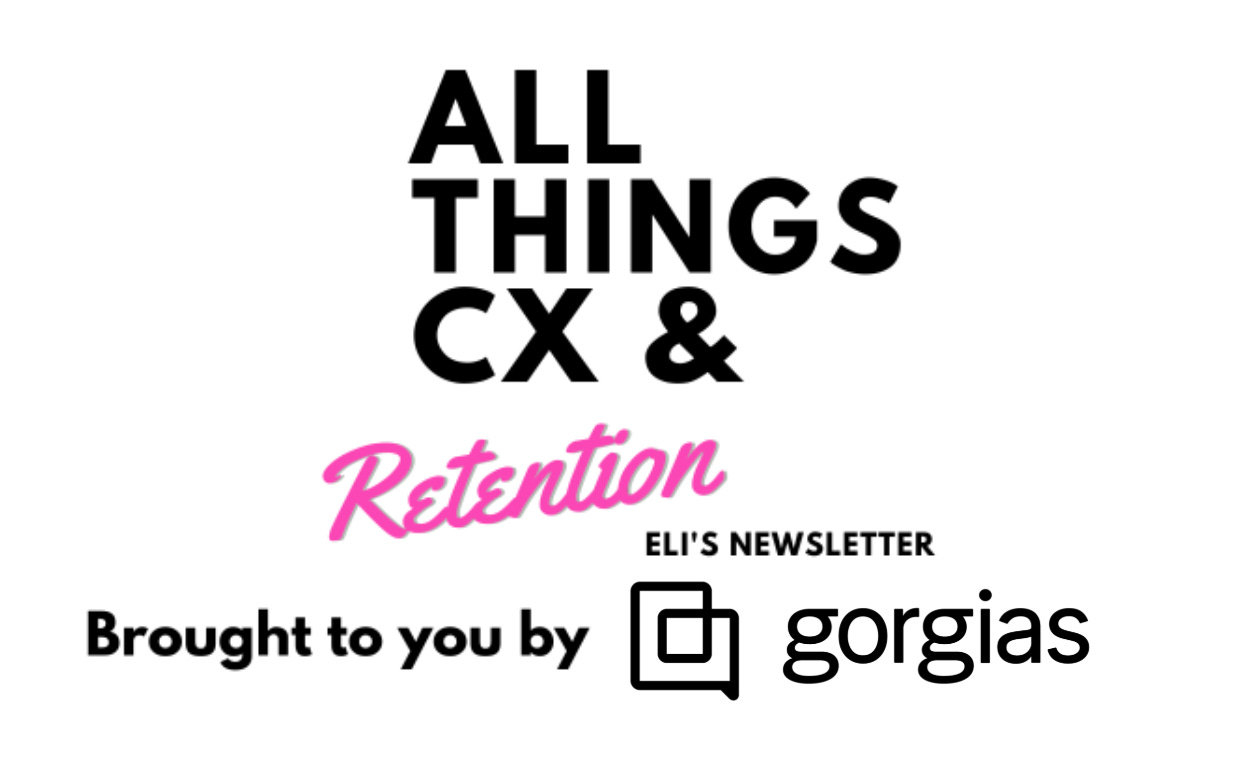This Is What Breaks Retention

Hi Team,
Back in New Jersey. Finally able to finish unpacking after we moved states and fled the country before even unpacking. 🙃
Something I kept thinking about on the long TLV to ATH to EWR flight:
CX plays a massive role in the brand experience when it’s done right, especially if you zoom out and define it as every customer touchpoint vs. just support.
But when it comes to support specifically, some of the best product companies in the world don’t need to be great. The product carries the weight.
Apple’s support is fine. It almost doesn’t matter. The iPhone earns loyalty on its own. Same goes for Bombas, Tommy John, and OLIPOP. Great product gives you margin for error.
But when the product stumbles because of slow shipping, a bad batch, or a broken experience, that margin disappears.
CX takes the angry emails. CX writes the apology copy. CX keeps the lights on while everything else scrambles.
Retention takes a hit, too. The job shifts from building long-term love to damage control. You go from welcome flows to sending 300 emails just to earn back a second purchase.
This one is for those times when CX and retention are left patching holes instead of building some real momentum.
I’ve got ideas for you.
Let’s get into it.

🛋️ In Case You Missed It: CX Lounge
Back in November, I had the chance to sit down with four of the most thoughtful voices in CX, Ren, Caela, and Michael, for what turned into one of the most meaningful conversations … I’ve maybe ever had on the state of our industry?
We covered everything from:
How CX teams can advocate for themselves
Why community is the secret ingredient to career growth
What still needs to change in eCom and CX
It was raw, honest, and most importantly, fun.

“I was almost in tears. We’ve come far — but there’s still so much to do.”
- Zoe Kahn - Founder of Inevitable Agency
“Elevating CX leaders means better lives for customers everywhere.”
- Michael Bair - Founder of Bair Consulting
“We could have our own CX show after this. The insight was unreal.”
- Caela Castillo - Director of CX at Jaxxon
“It’s not just about customer experience — it’s about the human experience.”
- Ren Fuller-Wasserman - Sr. Director of CX at Jaxxon
“The bar in CX is still low. We’ve come far, and there’s still a long way to go.”
— Me
Sign up here to watch the full conversation here → CX Lounge
If you’re in CX — or just care about building better customer experiences — this one’s worth your time.
Big thanks again to the Gorgias team for bringing us together.
When CX Gets Stuck Holding the Bag
I worked with a luggage brand a while back. The product was fine once it got to customers. The problem was getting it there. During one brutal stretch, Chinese New Year delayed us, then everything got jammed in customs. Warehouse ops were delayed. Tracking didn’t update. People were ordering for honeymoons, business trips, family vacations, and their bags just didn’t show up.
Support inboxes filled up. Macros had to be rewritten constantly. We sent quite a few updates to overshare on what was going on behind the scenes. Offered partial refunds when we could. Sent free accessories as apology gifts. CX didn’t cause the issue, but we were the ones catching every punch.
This kind of thing happens constantly. A beauty brand ships a faulty batch of pumps. A supplement brand sees its product melt in transit. A tech brand pushes out a few hundred units with firmware issues. Even if only 2% of orders are affected, you’re looking at hundreds of tickets, angry comments, reviews, and churn risk.
Most teams aren’t built to absorb that overnight. Retention feels it too. Flows start underperforming. Campaigns get angry replies. You end up sending apology emails just to hold the line.
When product wobbles, CX and retention are left holding it together. It’s brutal. But there are better ways to manage it.
When Product Pulls Its Weight
The best CX and retention teams can do incredible work. But the truth is, they are rarely the main reason a customer sticks around. The product does the heavy lifting. When it delivers, support doesn’t have to apologize. Retention doesn’t have to discount. Everything runs smoother. Flows convert. Campaigns perform. Loyalty builds without friction.
There’s this great interview with Kat Cole, the CEO of AG1, where she lays it all out. People have looked to AG1 as a top-tier retention brand for years. But here’s what she said:
“People gave us way too much credit for being amazing DTC marketers. We were not. We had a phenomenal product. It didn’t matter what type of marketing we used to have people learn about it. I’ve got 500+ customers who’ve been with us for a decade. That’s not because of a podcaster or a billboard, it’s their experience. DTC really has to have an incredible experience to have its chance. We were rewarded for our focus.”
It’s rare to hear something that honest from a brand operating at that level. But it makes sense. A product like AG1 gives its team breathing room. It buys grace. Even if something slips in CX or retention, the product experience wins people back. That’s the ultimate moat.
On the flip side, when the product is lagging, when shipping is delayed, when quality dips, when the unboxing disappoints, it’s CX and retention left to pick up the pieces.
And it’s not just the support team dealing with complaints. It’s the lifecycle team trying to keep customers warm while trust is shaky. It’s the campaign calendar that gets hijacked by the need to do damage control. It’s every team downstream from product, suddenly scrambling to hold the line.
There’s only so far CX and retention can go when the foundation is cracked. They can soften the blow. They can buy time. But they can’t fix a broken product. And if they try to carry that weight too long, the teams burn out.
That’s the reality. Great product lets you play offense. Bad product forces you into defense. Everything changes from there.
What to Actually Do When Product Slips
Here’s what I’ve seen work when product issues start bleeding into CX and retention. This isn’t theory. These are real tactics we used at OLIPOP, with the luggage brand, and with clients who needed to steady the ship when sh!t hit the fan.
1. Over-communicate, fast
Don’t wait until you’re drowning in tickets. If you know delays are coming or a product issue is active, start drafting. Send a plain-text update. Post a Help Center banner. Add a message to order confirmation flows. Customers want clarity. Even if you don’t have all the answers, say that. And say when you’ll update them again.
2. Give CX and retention real visibility
If your support or retention teams don’t know what’s going on, they’re flying blind. Get them in the loop early. Let them know what broke, how bad it is, what’s being fixed, and when updates are coming. That context lets CX draft accurate macros, prep escalation protocols, and respond with confidence. Retention can tweak flows, adjust offers, and avoid triggering angry customers with tone-deaf messages.
3. Adjust retention flows
Lifecycle flows are built for steady-state behavior. When things go sideways, those emails hit wrong. Pause the post-purchase flow. Rewrite campaign copy. Suppress churn nudges for affected segments. This isn’t about silencing marketing. It’s about timing it right.
4. Offer something upfront
Partial refunds. Free accessories. Loyalty points. A credit toward a future order. Whatever the gesture, make it early and clear. You don’t want to be asked for it. You want to be thanked for offering it. A little bit of proactive goodwill defuses a lot of tension before it gets even more hardcore.
5. Flag and segment affected customers early
Don’t wait for tickets to show you who’s pissed. If you know who’s getting the delayed order, the broken pump, or the half-melted bottle, tag them immediately. Suppress them from standard flows. Pause their surveys. Hold off on upsell pushes. Instead, build a segment-specific experience: an honest email, a clear apology, maybe an offer. Fixing it at the segment level beats trying to patch each ticket one by one.
Long-Term: Don’t Make CX and Retention the Scapegoats
The best CX and retention work happens when they’re building on top of something solid. When product is working. When operations are tight. When customers are already leaning in.
But too many brands treat them like a safety net. Product delayed? CX will clean it up. Quality dropped? Retention will fire off some discount code and try to win them back. Leadership shrugs and moves on.
That works once. Maybe twice.
Eventually it breaks. Customers leave. Teams burn out. And nobody wants to work at a brand where their whole job is apologizing.
If you’re a founder or operator reading this: make sure you’re not mistaking good CX for a good customer experience. And don’t confuse clever retention tactics with actual loyalty. Both of those things come from product. The rest is just scaffolding.
If you want long-term growth, give CX and retention something they can actually build on. Otherwise, you're just asking them to carry weight they were never built to hold.

That’s it for this week!
Any topics you'd like to see me cover in the future?
Just shoot me a DM or an email!
Cheers,
Eli 💛
P.S. If you want to figure out how to get your brand to rank high in LLMs and show up in ChatGPT, Gemini, and more… check this out.



